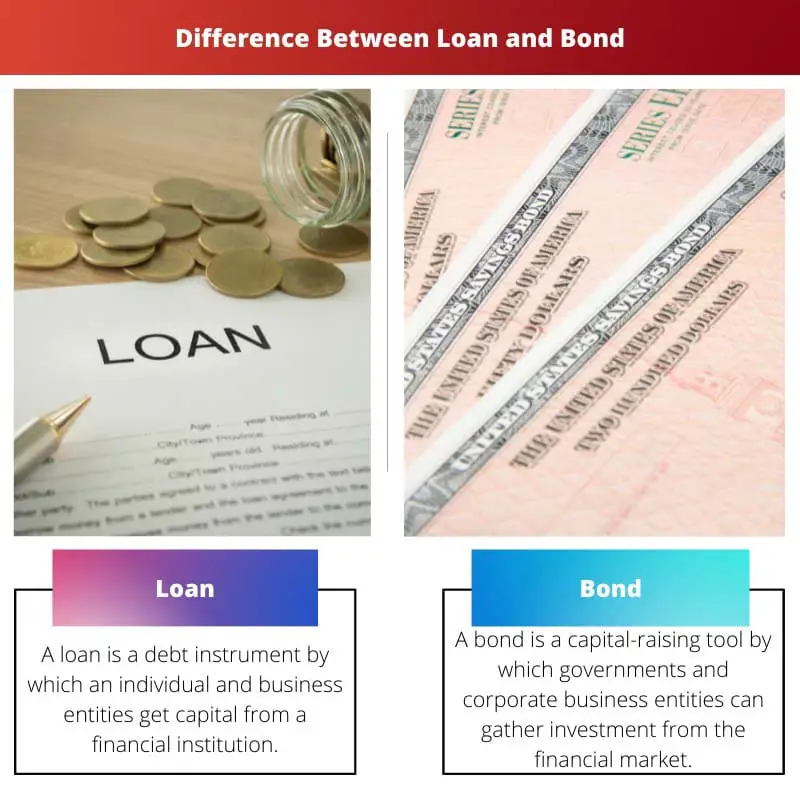A loan is a direct borrowing arrangement between a borrower and a lender, typically a financial institution, where the borrower receives a lump sum and repays it with interest over a specified period. In contrast, a bond is a debt security issued by a company or government to raise capital, with investors purchasing bonds as a form of lending.
Key Takeaways
- A loan is a borrowing arrangement between a lender and a borrower, with a fixed repayment schedule and interest rate, secured by collateral.
- A bond is a debt security issued by a corporation or government with a fixed interest rate and maturity date, which can be traded on secondary markets.
- Loans are direct agreements between lenders and borrowers, while bonds are marketable debt instruments, allowing investors to earn interest income and diversify their portfolios.
Loan vs Bond
The difference between Loan and a Bond is that a loan finance-raising procedure is for individuals and small business entities. In contrast, a bond is a capital-raising procedure for government, municipal agencies, and corporate entities.

Comparison Table
| Feature | Loan | Bond |
|---|---|---|
| Borrower | Individuals, businesses | Governments, corporations |
| Lender | Banks, financial institutions | Investors in the secondary market |
| Issuance | Private agreement | Public offering |
| Tradability | Not tradable (generally) | Tradable on the secondary market |
| Interest Rate | Fixed or variable | Fixed (usually) |
| Term | Shorter (months to years) | Longer (years to decades) |
| Repayment | Lump sum or installments | Periodic interest payments and principal repayment at maturity |
| Risk | Higher risk (based on borrower creditworthiness) | Lower risk (government bonds are typically considered very safe) |
| Purpose | Funding specific needs (e.g., car, house) | Raising capital for projects or operations |
What is Loan?
Types of Loans
1. Secured Loans
Secured loans are backed by collateral, which is an asset that the borrower pledges to the lender as security for the loan. Common examples include mortgage loans (secured by real estate) and auto loans (secured by the vehicle).
2. Unsecured Loans
Unsecured loans do not require collateral and are granted based on the borrower’s creditworthiness. Examples include personal loans and credit cards. Due to the higher risk for lenders, unsecured loans often have higher interest rates.
3. Fixed-rate Loans
In a fixed-rate loan, the interest rate remains constant throughout the loan term. Borrowers benefit from predictable monthly payments, making it easier to budget.
4. Variable-rate Loans
Variable-rate loans have interest rates that can change over time, typically influenced by market conditions. While initial rates may be lower, borrowers face the risk of rate increases, impacting monthly payments.
Key Components of a Loan
1. Principal Amount
The principal amount is the initial sum borrowed by the borrower. It is the baseline for calculating interest and determining the total repayment amount.
2. Interest Rate
The interest rate is the cost of borrowing and is expressed as a percentage. It determines the additional amount the borrower must repay beyond the principal.
3. Loan Term
The loan term refers to the duration over which the borrower must repay the loan. Shorter terms often result in higher monthly payments but lower overall interest costs.
4. Repayment Schedule
The repayment schedule outlines the frequency and amount of payments the borrower must make. Common schedules include monthly, bi-monthly, or quarterly payments.
Loan Process
1. Application
Borrowers initiate the loan process by submitting an application, providing details such as personal information, financial history, and the purpose of the loan.
2. Approval and Disbursement
After evaluating the borrower’s creditworthiness and financial situation, the lender approves the loan and disburses the funds. Terms and conditions are communicated to the borrower.
3. Repayment
The borrower repays the loan according to the agreed-upon schedule. Payments cover both principal and interest, gradually reducing the outstanding balance.
4. Completion and Closing
Once the borrower successfully completes the repayment, the loan is considered closed. Both parties may receive documentation confirming the closure of the loan agreement.
Importance of Loans
1. Financial Flexibility
Loans provide individuals and businesses with the flexibility to make significant purchases, investments, or handle unexpected expenses without the need for immediate funds.
2. Economic Stimulus
Loans play a crucial role in stimulating economic growth by providing capital for businesses to expand, invest, and create job opportunities.
3. Homeownership
Mortgage loans enable individuals to achieve homeownership by spreading the cost of a home over an extended period, making it more accessible.
4. Education and Personal Development
Student loans facilitate access to higher education, contributing to personal and societal development by investing in human capital.
What is Bond?
Types of Bonds
1. Government Bonds
- Definition: Issued by governments to fund public projects or manage fiscal deficits.
- Examples: Treasury bonds, municipal bonds.
- Risk Level: Generally considered lower risk due to government backing.
2. Corporate Bonds
- Definition: Issued by companies to raise capital for various purposes, such as expansion or debt refinancing.
- Examples: Investment-grade and high-yield bonds.
- Risk Level: Varies; higher risk for high-yield (junk) bonds.
3. Mortgage-Backed Securities (MBS)
- Definition: Backed by a pool of mortgages, providing investors with a share of the interest and principal payments from the underlying loans.
- Examples: Mortgage-backed bonds.
- Risk Level: Linked to the performance of the underlying mortgages.
4. Municipal Bonds
- Definition: Issued by local governments or agencies to finance public projects like schools and infrastructure.
- Examples: General obligation bonds, revenue bonds.
- Risk Level: Varies; often perceived as lower risk than corporate bonds.
Bond Characteristics
1. Face Value
- Definition: The nominal or dollar value of a bond, representing the amount the issuer promises to repay at maturity.
2. Coupon Rate
- Definition: The fixed annual interest rate paid by the issuer to the bondholder, expressed as a percentage of the face value.
3. Maturity Date
- Definition: The date when the bond will be repaid in full by the issuer.
4. Yield
- Definition: The return on investment for a bond, considering its current market price, coupon interest, and time to maturity.
5. Credit Rating
- Definition: A measure of the issuer’s creditworthiness, assigned by credit rating agencies.
6. Call and Put Provisions
- Definition: Call provisions allow the issuer to redeem the bond before maturity; put provisions give the bondholder the right to sell the bond back to the issuer.
Risks Associated with Bonds
1. Interest Rate Risk
- Definition: Changes in interest rates impact bond prices inversely.
2. Credit Risk
- Definition: The risk of the issuer defaulting on interest or principal payments.
3. Inflation Risk
- Definition: The risk that inflation erodes the purchasing power of future bond interest and principal payments.
4. Liquidity Risk
- Definition: The risk that a bond cannot be quickly sold or bought in the market without a significant price change.

Main Differences Between Loan and Bond
- Nature of Debt Instrument:
- Loan: A loan is a form of debt where a borrower borrows a specific amount from a lender and agrees to repay it, typically with interest, over a specified period.
- Bond: A bond is a debt security that represents a loan given to a company or government by an investor. Bonds are typically traded on the financial markets.
- Number of Lenders:
- Loan: Usually involves a bilateral agreement between a borrower and a lender, meaning there is typically only one lender.
- Bond: Involves multiple investors who buy the bonds issued by the borrower. Bonds are often traded in the secondary market.
- Maturity Period:
- Loan: Typically has a fixed maturity period agreed upon by the borrower and the lender.
- Bond: Can have varying maturity periods, ranging from short-term (e.g., a few months) to long-term (e.g., several decades).
- Customization and Negotiability:
- Loan: Terms and conditions are often negotiable between the borrower and the lender, allowing for a more customized agreement.
- Bond: Generally has standardized terms and conditions, and the bond’s features are often set by the issuer.
- Transferability:
- Loan: Generally not transferable between parties without the consent of the lender.
- Bond: Can be freely traded in the secondary market, allowing investors to buy and sell bonds without the issuer’s involvement.
- Security:
- Loan: May be secured or unsecured. Secured loans have collateral attached to them, providing the lender with a claim on specific assets if the borrower defaults.
- Bond: Can be secured or unsecured, with some bonds backed by specific assets or revenue streams.
- Interest Payments:
- Loan: The borrower typically makes periodic interest payments and repays the principal amount at maturity.
- Bond: Interest payments (coupon payments) are made periodically, and the principal is repaid at maturity.
- Issuer Type:
- Loan: Borrowed from financial institutions, banks, or private lenders.
- Bond: Issued by corporations, municipalities, or governments to raise capital from the public.
- Market Listing:
- Loan: Not typically listed on public exchanges; terms are negotiated privately.
- Bond: Can be listed and traded on public exchanges, providing liquidity to bondholders.




